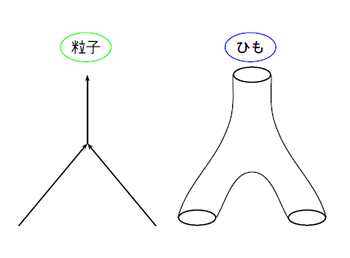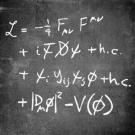research topic: superstring theory
General relativity and quantum mechanics
In the first half of the 20th century, we have witnessed a radical paradigm shift in theoretical physics. In particular, the discovery of general relativity and quantum mechanics had a tremendous impact on our understanding of Nature and changed our view of Nature completely. The general relativity is a theory describing the large scale phenomena in physics, like the motion of stars or the evolution of the universe. On the other hand, the quantum mechanics is necessary for the study of very small scale physics, such as atoms and molecules.
According to the Einstein's theory of general relativity, if a star has a very large mass it becomes the so-called black hole and even the light cannot escape from it. Originally the existence of black holes was predicted theoretically, but later it was confirmed by the observations thanks to the recent development of observational technologies in astrophysics. One of the most famous examples is the supermassive black hole at the center of our Milky Way galaxy, whose mass is a million times larger than the solar mass.
On the other hand, according to the quantum mechanics a particle does not move on a definite trajectory as in classical mechanics; instead we only know the probability of the final state which is determined by summing over the various possible trajectories of the particle. Based on this rule of quantum mechanics, one can explain theoretically the spectral lines of light emitted from the hydrogen atom with a definite wavelength.
However, it does not work well if we try to combine the general relativity and the quantum mechanics together, although they are perfectly capable of explaining physical phenomena if we use them separately. What the hell is going on?
Actually, the reason for this failure of marriage is partly understood. This is related to the fact that the typical size of an object behaves in a completely opposite way in general relativity and quantum mechanics, as we change the mass of the object. The general relativity predicts that the size of black hole is proportional to its mass. On the other hand, the quantum mechanics tells us that a particle behaves like a wave with the wavelength inversely proportional to the mass of the particle. Namely, the typical size of an object is proportional to its mass in gravity, while it is inversely proportional to the mass in quantum mechanics. This completely opposite behavior of the size is the reason why it is difficult to combine the theory of gravity and the quantum mechanics.
What is the superstring theory?
Then, how to combine the theory of gravity and the quantum mechanics in a consistent way? The answer is the superstring theory! This is a theory based on the postulate that the fundamental building block of matter is not a particle, but a string. The reason why this idea works is that.... If you are interested and want to learn more about this theory, please become the student of Shinshu University and visit my office.
Goodbye, spacetime
Around the time when I just entered the university, Stephen Hawking, a theoretical physicist on the wheel chair, became popular in Japan and his book "A Brief History of Time" was a best seller. I found the book in a bookstore and read it. I didn't know much about physics at that time and I couldn't understand the details of the book. When I read about the difficulty of combing gravity and quantum mechanics in that book, I vaguely thought that I would like to study that kind of stuff or something like that.
I remember that a figure of the card of King was drawn in one page of that book, and he explained that the figure does not change if we rotate it by 180 degrees. It took a long time for me to understand that the figure was intended to explain to layman the fact that the graviton -- a particle mediating the force of gravity -- carries the spin 2. Hawking also explained briefly about the superstring theory in his book, and the following figure was on the book (maybe the details of this figure are a bit different form the original one in his book).

The left figure shows that the two particles collide and merge, then exit as a single particle. The right figure shows that the two closed strings collide and merge. Hawking explained that the interaction of strings in the right figure would solve the problem of the difficulty of combining gravity and quantum mechanics. When I read about this theory, I thought "hmm, interesting" but I didn't imagine I would be a researcher of string theory in the future.
However, when I entered the graduate school there was a huge progress in the field of string theory and the atmosphere was like "now is the time to study string theory and nothing else". Then it was natural for me to choose string theory as a research topic. But the main theme at that time was to study various aspects of string theory, rather than the deep question of the unification of gravity and quantum mechanics.
After spending several years as a postdoc in abroad, I became a member of Shinshu University in 2006. Here in Shinshu I started to think about my dream from my freshman year, i.e. the unification of gravity and quantum mechanics which I didn't have much time to work on when I was a postdoc. It became gradually clear that our everyday notion of "spacetime" should be abandoned in the final theory. The spacetime is a combination of space and time, which sets the stage for the Einstein's general relativity. However, the spacetime is a classical notion and it might not exist in quantum theory of gravity. But one might ask "hey, how could it be possible to describe a physical phenomenon if there is no space and time?"Although the superstring theory is still an unfinished project, when it is understood completely the concept of spacetime would become an old language to describe a new physics.
To conclude, we quote from Analects of Confucius:
"The Master, having come to Wu-ch'ang, heard there the sound of stringed instruments and singing. Well pleased and smiling, he said, why use an ox knife to kill a fowl?"
My dream is understanding the quantum theory of gravity using the ox knife of superstring theory.






